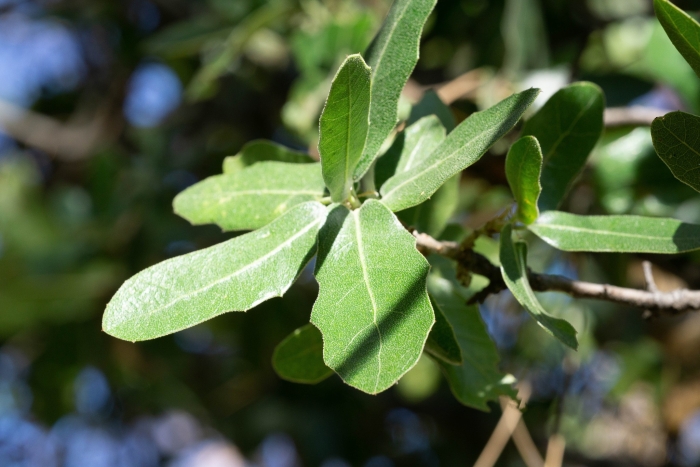Emory Oak
(Quercus emoryi)
Emory Oak (Quercus emoryi)
/
/

© Jake Nitta
CC BY 4.0
Image By:
© Jake Nitta
Recorded By:
Copyright:
CC BY 4.0
Copyright Notice:
Photo by: © Jake Nitta | License Type: CC BY 4.0 | License URL: http://creativecommons.org/licenses/by/4.0/ | Uploader: froggy143 | Publisher: iNaturalist |























Estimated Native Range
Summary
Quercus emoryi, commonly known as Emory Oak, is a semi-evergreen tree native to the oak woodlands and pine-oak forests in the Southwestern United States and Northern Mexico, including Arizona, New Mexico, western Texas, and northern Mexico. It exhibits a moderate growth rate and typically reaches heights of 16–56 feet. Emory Oak has a distinctive appearance with leathery, dark green leaves and a form that can vary from shrubby to a well-defined tree. The acorns are blackish-brown, maturing in 6–8 months, and are a crucial food source for wildlife.
Emory Oak is valued for its hardiness and adaptability to arid conditions, making it suitable for xeriscaping and as a shade tree in hot climates. It is also used for restoration projects and as a food plant in traditional Native American agriculture. In cultivation, it requires minimal water once established, thrives in well-drained soils, and prefers full sun to partial shade. While it is generally disease-resistant, it can be susceptible to oak wilt. Emory Oak’s acorns are still harvested by Native American tribes as a traditional food source. The tree’s ability to withstand drought and poor soil conditions makes it an excellent choice for challenging landscapes, but it may face habitat challenges from fire suppression, grazing, and climate change.CC BY-SA 4.0
Emory Oak is valued for its hardiness and adaptability to arid conditions, making it suitable for xeriscaping and as a shade tree in hot climates. It is also used for restoration projects and as a food plant in traditional Native American agriculture. In cultivation, it requires minimal water once established, thrives in well-drained soils, and prefers full sun to partial shade. While it is generally disease-resistant, it can be susceptible to oak wilt. Emory Oak’s acorns are still harvested by Native American tribes as a traditional food source. The tree’s ability to withstand drought and poor soil conditions makes it an excellent choice for challenging landscapes, but it may face habitat challenges from fire suppression, grazing, and climate change.CC BY-SA 4.0
Plant Description
- Plant Type: Shrub, Tree
- Height: 40-60 feet
- Width: 40-60 feet
- Growth Rate: Moderate
- Flower Color: N/A
- Flowering Season: Spring
- Leaf Retention: Evergreen, Semi-deciduous
Growth Requirements
- Sun: Full Sun, Part Shade
- Water: Low, Medium
- Drainage: Fast, Medium
Common Uses
Drought Tolerant, Low Maintenance, Street Planting
Natural Habitat
Oak woodlands and pine-oak forests
Other Names
Common Names: Bellota, Emory’s Oak, Desert Live Oak, Black Oak
Scientific Names: , Quercus emoryi, Quercus balsequillana, Quercus duraznillo, Quercus duraznillo f. bullata, Quercus duraznillo f. cochutensis, Quercus duraznillo f. pinetorum, Quercus hastata,
GBIF Accepted Name: